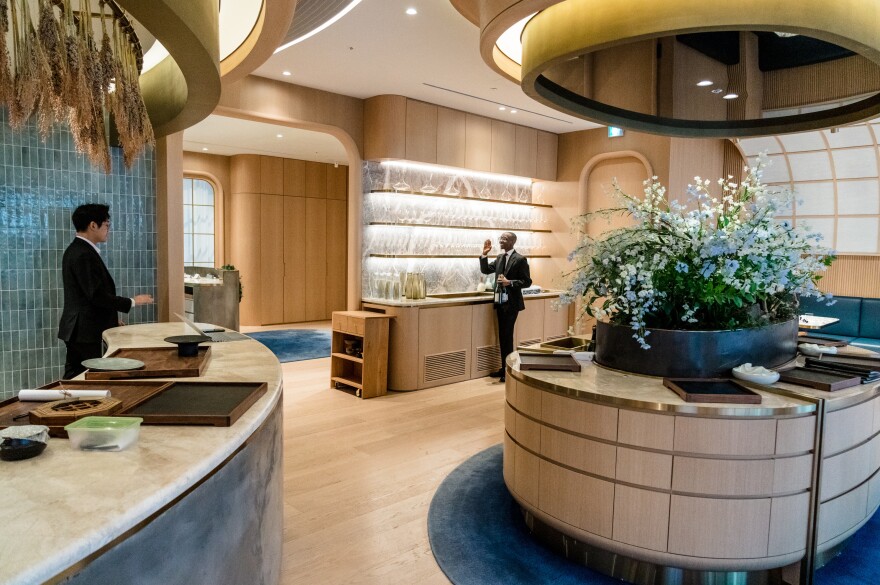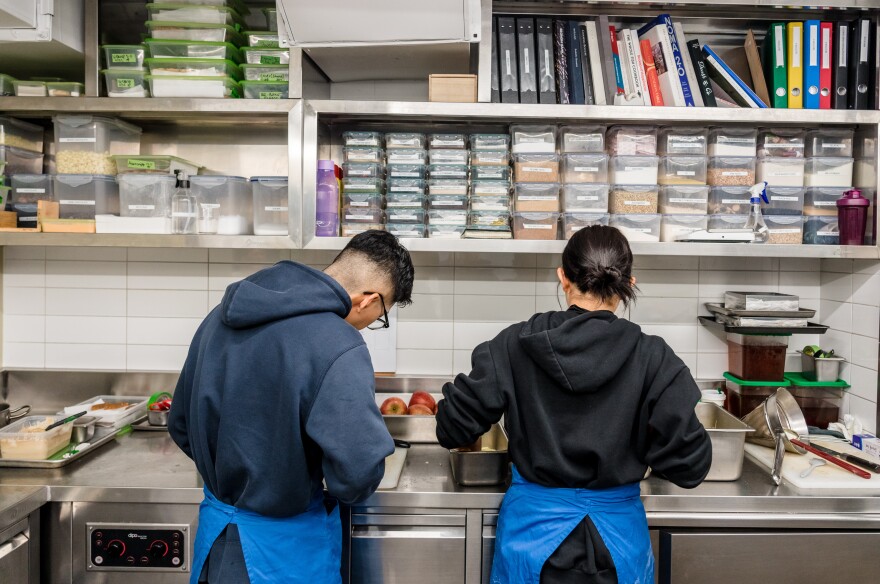SEOUL, South Korea — How do you reinterpret a simple traditional dish into food that wins awards and commands a high price at a fine dining restaurant? Here's an example:
For a final course at Evett, a restaurant in Seoul's trendy Gangnam district, Australian chef Joseph Lidgerwood grills a chunk of Korean beef over a wood fire.
Then, he distills an inexpensive bowl of white rice and a dollop of brown doenjang — a paste of salty, fermented soybeans — reducing them to a small white puree with brown stripes, to accompany the beef.
Lidgerwood confesses that "the thing that I always wrestle with at fine dining restaurants is that sometimes it never tastes as good as the traditional Korean stuff."
He says he asks himself, "this tastes amazing, how can we bring this back to Evett? How can we make this into a dish that can be served at a location like this?"
While foreign-run, Evett is part of Seoul's burgeoning gastronomic scene driven largely by South Korean chefs.
Their success in fine-tuning Korean food helped them scale the heights of haute cuisine, adding the taste of success to the many other trophies of South Korea's cultural power.
And en route to the top, Korean chefs and their creations have gotten a strong boost from other South Korean cultural exports, which have whetted international appetites for other Korean cultural genres.
In New York, two of 12 Michelin star awards last year, and three of 19 in 2022, went to Korean restaurants.
"Something that I never thought would happen in my lifetime, especially to Korean food, is happening," muses Cho Hee Sook, often referred to as the "Godmother of Korean cuisine."
She got her start in the 1980s, when the only fine dining in South Korea was in hotels, and chefs were considered a lowly profession.
The rise of haute Korean cuisine
Evett, meanwhile, has been listed in the Michelin Guide since 2020, with one star for its high-quality cooking.

Lunch at Evett costs about $114 per person, dinner about $119, not including wine.
"I'm not from Korea, but I have a love affair with Korean ingredients," says Evett's chef Lidgerwood. His aim with all his dishes, he says, is "to present them in different ways, to make people kind of look back at the past."
One of his signature creations, for example, is a "Meju doughnut." Meju is a beige brick of dried, fermented soybeans, from which three fundamental ingredients of Korean cuisine — soy sauce, fermented soybean paste and chili paste — are made.

The brick is there to show you something about how Korean food is made. What you eat is a ball perched atop the block, a donut made with caramelized cream, anchovies and black garlic, and a dusting of powdered meju on top.
Another course is served in a dish made to look like a traditional Korean hat, filled with radishes and onions cooked in Korean makgeolli liquor and abalone, and topped with a perilla seed cracker.
There's a wooden Korean window frame that holds sweets including a ginseng marshmallow and a sesame oil caramel.
Lidgerwood's dishes reflect Korea's traditional use of seasonal ingredients, supplemented by taking fresh foods and preserving them through fermentation. Some he acquires on his roughly dozen annual foraging trips around South Korea.
"We have an amazing library of fermented stuff that we can pull and pick as we choose," he says.
Many of Lidgerwood's dishes cater to Koreans' love of foods that are simultaneously sweet and salty. Many others have a creamy consistency more like European cuisine than Korean.
But chef Junghyun Park, chef and owner of the two-Michelin-starred Atomix and three other New York restaurants, says that, for him, at least, Korean haute cuisine is not about adapting traditional Korean foods to suit Western palates.
"I like cooking in New York because people there are very open to new cultures," he explains. "They like accepting new things. So it's not like I have to change to their tastes."
In other words, he just serves what he thinks tastes good. And he also dismisses the notion that Korean chefs have suddenly burst upon the global fine dining scene.
"They all started cooking around the early 2000s, like myself," he says, "and have trained as chefs for nearly 20 years, developing their own culinary styles. I think such efforts are now bearing fruit."
Traditional dishes with a modern twist
Chef Cho Hee Sook says one of her main aims is to update traditional Korean cuisine to reflect modern lifestyles.
Traditional Korean meals are centered on rice, served with side dishes called banchan.
Due to both exposure to foreign foods, and health-conscious efforts to cut carbs, she says, "more and more people are excluding rice from their table now and having what would have been banchan as standalone dishes."

Many banchan and other traditional Korean foods make liberal use of soy sauce, chili paste and fermented soybean paste, to add flavor to the bland rice.
"Without rice, those flavorings are too salty," Cho says. "But as you try to assemble a fine dining course without rice, you soften the flavor of the traditional fermented pastes."
And, she adds, out of concern for hygiene, especially since COVID-19, many Korean restaurants are now serving meals in individual portions, rather than shared dishes in the middle of a table, another trend reflected in Korean haute cuisine.
A rising tide of Korean cultural exports
A key ingredient in the success of Korean haute cuisine is the rising tide of other South Korean cultural exports, from K-pop bands including BTS and BLACKPINK to movies like Parasite and the TV series Squid Game.
And South Korea's government and corporations are thinking of ways to promote Korean food abroad and profit from it.
"Our ultimate goal is to increase exposure of Korean food overseas and through that, increase exports of Korean agricultural and food products," explains Yang Joo-pil, an official in charge of food industry policy at the Ministry of Agriculture, Food and Rural Affairs.
To do this, his ministry is finding ways to link Korean food to other facets of Korean culture.
"For example, we select about 10 food items each year for product placements in dramas," he says, referring to TV shows. They also sell Korean food at K-pop concerts overseas.
South Korea's largest food company, CJ Foods, meanwhile, aims to sell more of its frozen dumplings, chili paste, kimchi and other foodstuffs overseas, by cultivating rising young chefs like Evett's Lidgerwood.
Lidgerwood's culinary offerings are rich in culinary information. Putting that much cultural content "might seem like a lot of work, for people who aren't as interested in meeting the cow and the farmer," he quips.
"But for us it's a kind of a joy," he adds. "So that's why we get up every morning."
Jen Kwon and Se Eun Gong contributed to this report in Seoul.
Copyright 2024 NPR. To see more, visit https://www.npr.org.



